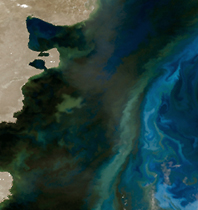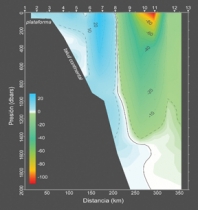|
 |
 | Edge of the continental shelf, the current patterns are made visible by the phytoplankton that color the water. Satellite image.  |
 |
The Malvinas Current is derived from the northern arm of the Antarctic Circumpolar Current and, on crossing the Drake Passage, separates into two arms. The main branch moves along the edge of the continental slope, transferring cold, nutrient-rich waters northwards. The western branch helps form the Patagonian Coastal Current which moves northwards over the continental shelf. The Brazil Current enters the system from the north and meets the Malvinas Current in the Confluence Zone. This collision of masses of different waters creates intense thermal and saline gradients and leads to the formation of eddies and productive fronts.
Map of marine currents adapted from Piola and Matano (2001).
| © SeaWiFS Project, NASA |
 |
Malvinas and Brazil Currents |
 Currents Velocity Currents Velocity |
Velocity section of marine currents (in cm/s) across the outer shelf and continental slope near 38-39ºS. Light blue colors: northward flow (positive values), associated with the Malvinas Current. Green-yellow-red colors: southward flow (negative), associated with the Malvinas Return Current and the Brazil Current. The heavy contour (0 cm/s) marks the transition between northward and southward flow. Background map: location of hydrographic stations (white circles).
Currents velocity data contributed by A. Piola (SHN-UBA-CONICET, Argentina).
 | |
|
 |
Marine Currents
The Patagonian Sea is dominated by two marine currents. The temperate Malvinas Current, that follows the contour of the shelf slope, represents the backbone of the ocean system. The warm Brazil Current which, in contrast, has low nutrient concentrations. These currents affect both the deep ocean and the shallow shelf.
|

